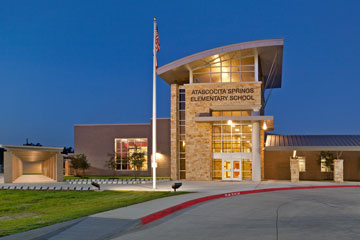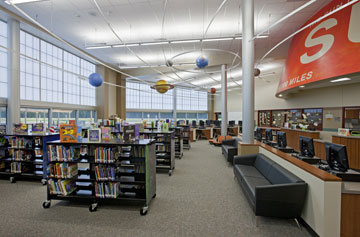Texas School Looks for Dual Certification

ATASCOCITA, Texas — Despite having only been open a few months, Atascocita Springs Elementary School is already making history as the first school in its district to achieve LEED certification.
The school, a part of the Humble Independent School District located northeast of Houston, was designed by Houston-based PBK, a comprehensive planning and design firm.
Atascocita Springs opened in fall 2010 and is hoping to add to its achievements by becoming one of the first verified Collaborative for High Performance Schools in Texas.
The Atascocita Springs campus was designed with several features that led to its certification, including low-flow plumbing fixtures, native and drought-resistant plants to conserve water, solar panels, reflective site paving and specialized roofs that keep the building from absorbing heat, and recycled content materials used during the building process, according to a statement from PBK. The two-story, three-winged building faces north to south to take advantage of natural light and minimize the use of overhead lighting.
The state of Texas also adopted CHPS standards in 2009, which set guidelines for a high performance school’s design and construction that improves the learning environment while saving energy, resources and money. To meet the criteria for these standards, Atascocita Springs was constructed as a learning environment and a learning tool both inside and out, according to PBK.

The structure features two learning bridges that integrate the science curriculum to teach about magnetism and to study friction, speed and inertia; and interactive kiosks throughout the building for students to monitor and log the school’s solar, water, gas and electrical use.
Every classroom opens up to learning courtyards that include sundials, hundreds charts and number lines to emphasize the enhanced math curriculum requirements, and each wing has a collaboration space to serve as the hub of learning for each wing, according to the design firm.
The collaborative spaces are lit up by natural daylight by large, storefront windows, and are complete with movable marker and tack boards, and a marker/projection wall.
Each wing and collaborative space includes its own ecosystem-based theme, represented on the ceiling treatment in the collaboration space and on magnetic murals at the entrances to each wing, which are taught in the grade levels in that building.
Students can also take in the learning experiences as they walk through the hallways, with proportioned wall tiles that teach students about fractions, and windows from the classrooms to the hallways that allow teachers to monitor learning both inside and outside of the classroom.
